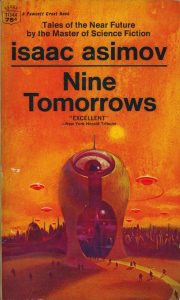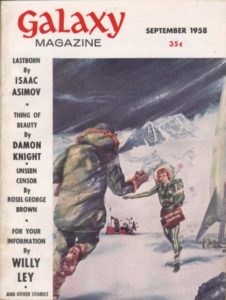 I’m going to revise this blog, which has been dormant for a while, and what better way to start than with an Isaac Asimov (1920-1992) story on his birthday. Asimov is one of the classic authors whose work I want to either reread or read for the first time this year.
I’m going to revise this blog, which has been dormant for a while, and what better way to start than with an Isaac Asimov (1920-1992) story on his birthday. Asimov is one of the classic authors whose work I want to either reread or read for the first time this year.
I read quite a bit of Asimov when I was in middle school and high school and have dipped into his work from time to time since then. I read the Foundation and robot stories, several of the collections (Nightfall, The Bicentennial Man, The Early Asimov, and I think Buy Jupiter) and a couple of the early novels. There’s still a good bit of his work I haven’t read. Plus, it’s been so long since I read most of the above, it will almost be like coming to those works new.
 Today, January 2, is Asimov’s birthday. I’ve not read “The Ugly Little Boy” before. It was originally published under the title “Lastborn” in the September 1958 issue of Galaxy Science Fiction. The title was changed to “The Ugly Little Boy” when it was reprinted in 1959 in the collection Nine Tomorrows.
Today, January 2, is Asimov’s birthday. I’ve not read “The Ugly Little Boy” before. It was originally published under the title “Lastborn” in the September 1958 issue of Galaxy Science Fiction. The title was changed to “The Ugly Little Boy” when it was reprinted in 1959 in the collection Nine Tomorrows.
This is a tragic story about how scientific ambition clouds humanitarian motives. The titular ugly little boy is a Neanderthal child who has been pulled from the past. Because of the temporal potential energy he has from being pulled forward, he is kept in a stasis room.
The story is told from the point of view of the nurse hired to take care of him. Although initially repulsed by his appearance, she soon grows to love him and names him Timmie.
The mechanism for pulling something from the past has limits, both near and far in time. Historical periods are too near in time. Eventually, though, that problem is solved. A successful test brings a peasant forward from the middle ages.
By bringing forward, I mean they kidnap him.
Just like they did with Timmie.
 The scientist who developed this process understands the ethical problems with what he’s done, but ultimately, they are set aside for his ambition.
The scientist who developed this process understands the ethical problems with what he’s done, but ultimately, they are set aside for his ambition.
One thing I found interesting, and which might be a turn off to contemporary readers, was the relationship between the nurse and the lead scientist. She’s single, and he’s married. The nurse is both attracted to him and repulsed by him. I thought this romantic tension, which wasn’t a major plot point, added depth to the story. Some people today might see it as stereotypical of the late 1950’s. YMMV.
“The Ugly Little Boy” is worth reading. Asimov handles the tension between scientific research and humanitarianism well. I can see why it’s regarded as one of his best shorter works.

Good to see a new post here!
Thanks. I’m hoping to keep this blog fairly active this year. We’ll see.
It has been forever since I read this story– does the nurse go back in time with Timmy?
Yes, she did.
Hah, following up over 6 months later!
I’ve always kicked around the idea of writing a follow-up story called “the Beautiful Horrible Huntress”, from the ugly little boy’s POV where, back in the past, the nurse is absolutely unprepared for the rigors of the paleolithic. I might lean into the humor or maybe the pathos.
You should write that.